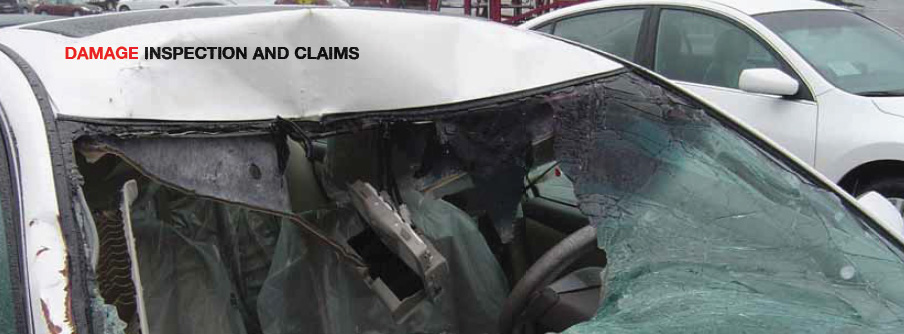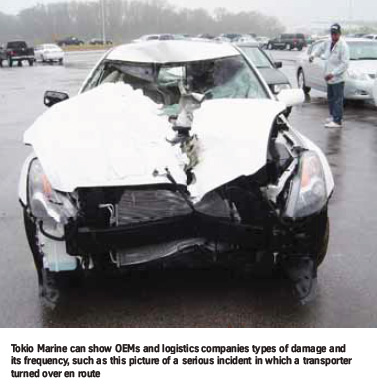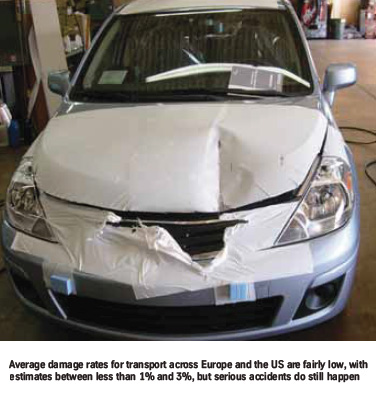
Although vehicles often face hazardous journeys by ship across rough seas or inland through busy cities, the process of transporting vehicles in a damage-free way in developed and developing countries is becoming an ever-more refined art. Tim J Doonan, of Tokio Marine Claims Service in the US, says that cars used to get swung onto ships and serious damage was caused to a high percentage of them. Although risks still occur nowadays in moving a car from the plant to the port, or while loading the vehicle onto or off the vessel, over the decades technology has improved and the rate of damage has plunged, he says.
In most cases only a vehicle’s bumper gets knocked or paintwork now gets scratched while a car is being parked or loaded,” Doonan explains.
Statistics show that damage to vehicles transported across Europe or North America remains low. Matt Holmes, a director at Pound Gates Vehicle Management Services, estimates that on average 3% of the 14.5m vehicles in transit in Europe are damaged every year. This is at an average cost of €400 ($508) per vehicle, says Holmes. Other manufacturers or insurers estimate the level of damage even lower, at less than 1% of transported vehicles in the US or Europe.
But even so, Holmes points out that this vehicle damage is a cost that benefits no one in the supply chain. It delays the delivery of the vehicle and can hurt the brand as well as frustrate customers, Holmes says. But by reducing damage through pro-active identification of causes, the insurance rates can be trimmed and more vehicles will reach their destination in the right condition. The vehicle can then be handed over to the end recipient as originally promised, he says.
Driving claims lower in Europe
Gary Wall, quality manager for the vehicle logistics group at Toyota Motors Europe says the claims process is usually  straightforward and handled by the manufacturer’s insurance company, Tokio Marine Europe Insurance.
straightforward and handled by the manufacturer’s insurance company, Tokio Marine Europe Insurance.
Tokio Marine provides insurance coverage from the plant to dealers for Toyota across Europe. Where Toyota needs to repair vehicles, the OEM issues an invoice for damage after inspection and Tokio Marine recovers the damages against the liable party. Tokio Marine also provides regular statistics that helps to support damage prevention, Wall says.
Toyota sets damage reduction targets with its contracted trucking, vessel and rail companies. The manufacturer looks at previous damage levels and usually targets reductions of some 5-10% compared to the previous year. “Damage levels and subsequently damage prevention are a major concern for Toyota,” Wall says.
Wall explains that different modes of transport offer different challenges and varying types of damage. In 2009, Toyota saw a damage level of 0.76% for 1.2m cars transported in Europe compared to 0.82% in 2008 and 0.97% in 2007. The target for 2010 is a further reduction to 0.72%. “We are slightly above target currently and working to improve,” Wall says.
Damage prevention is carried out for all modes of transport such as trucks, rail, short-sea and deep-sea vessels. Open rail, in which the cars are secured to the platform of a wagon, saw 4.5% of damage to 78,000 cars in Europe in 2009 for Toyota, while closed rail–where car are inside wagons–saw just 0.61% for 48,000 cars transported in the same period, Wall says. Wall says that transporting cars by open rail is more complex than when shipping them with a closed rail wagon or by truck and usually results in higher levels of damage as the cars risk damage when the journey passes through built-up urban areas. As a result vandalism and theft can occur. But open rail is necessary, because some regions of Europe lack enough closed wagons.
 The region or country is also important in terms of the likelihood of damage. In the case of open rail, a higher rate of theft or vandalism occurs typically in Italy and Poland for Toyota, probably because of routing. The carmaker also sometimes finds that damage can occur at the point of unloading, where other companies are responsible for taking the car from the truck or wagon. Responsibility then lies with the local sales company in each country.
The region or country is also important in terms of the likelihood of damage. In the case of open rail, a higher rate of theft or vandalism occurs typically in Italy and Poland for Toyota, probably because of routing. The carmaker also sometimes finds that damage can occur at the point of unloading, where other companies are responsible for taking the car from the truck or wagon. Responsibility then lies with the local sales company in each country.
Toyota Motor Europe mitigates some of its damage risk through it use of many varied providers across all modes of transport. Some examples include Mosolf and Walon for trucking, while for deep-sea vessel shipments from Japan NYK, K-Line, WWL and MOL are used. For short-sea routes, such as from Belgium to the UK, Toyota uses Toyofuiji, and for the sea route from Sweden to Finland KESS is used. Toyota Motor Europe also continuously works with its logistics partners to reduce damage across its European operations. In one case, Wall recalls that chips were often spotted on cars’ bumpers, so the company traced the damage by working with the shipping company, the local stevedores, as well as the local agent.
Wall says that the damage was traced back to the first point of rest in Livorno in Italy, which had small stones in the yard. This is typical of Toyota’s kaizen process of making small steps to improve a situation, Wall says. Step-by-step the damage was traced and then the solution implemented, he says. “By simply sweeping the area, the damage was eliminated.”
In another example, scratches were often found on the side of bumpers that came from certain ports. Toyota discovered that the damage was caused when stevedores carelessly unlashed the vehicle. “This is very specific information and it isn’t rocket science,” he says. But the manufacturer, the insurer and the carriers need to study the damage, check the route, and see what caused the problem, he says.
This often requires close cross-border cooperation. With vessels coming from Japan, Toyota officials need to meet with all interested parties that loaded the ship as well as the unloaders in other countries and the carriers. “Meetings can resemble the United Nations at times,” Wall says.
OEMs trim damage in the US
Manufacturers are increasingly using IT systems and data provided by companies such as Tokyo Marine to identify damage and iron out problems. Mazda’s Scott A Mize says that Mazda ships around 220,000 vehicles in the US a year and the damage is minimal. The claims are less than 1% of vehicles transported across the country, he reveals.
The rules for insurance claims in the US are fairly clear and standardised so it is easy to determine who has liability and needs to pay for any damage. Mazda has a risk management team that processes claims and collects data about any damage from its logistics suppliers such as the trail or truck company. The process is standard for most cases, according to Mize. Moreover, most damage tends to be caused by technical hitches such as chains securing the car breaking or adverse weather such as snow or ice leading to chips in the car’s paintwork. Mize says that the highest risk occurs as the car is loaded onto the trucks at the factory or in the patio or on unloading. “You therefore need to minimise handling and moving,” Mize says.
Typically, in the case of Mazda–as with most OEMs–cars built in the US are loaded onto rail or trucks and shipped to 20 or 30 central locations before being trucked to the final destination. From outside of the US, cars arrive at ports such as San Diego on the west coast or New Jersey on the east coast. The cars are then transported to a central location such as Houston, Memphis or Chicago where they get trucked to the final destination.
Mazda in the US uses all of the major rail companies and the top trucking companies, such as Allied Systems on the east coast, to transport its vehicles. The number of claims against carriers is “tiny”, he says.
Mize says improvements in the US are varied and could relate to the types of chocks used (materials placed on the outside of tyres to stabilise cars). The carriers could also use straps rather than tight chains that slash the number of dents and scratches. Also, rail companies increasingly put protection inside the wagons such as foam where door edges might hit the wall, he says.
Insurers eye deeper integration
But when a car does get dented or a bumper scratched, OEMs, carriers and insurance companies are increasingly working closely together to identify and process the claim smoothly. They are also able to minimise the damage in future by tapping a wealth of data about the damage. This is important to stamp out or lower the level of damage in transit, according to industry experts.
Indeed, Tokio Marine’s Doonan says that insurance companies in the US are covering more business areas and can build up valuable information to know more about the OEM’s business.
This trend was accelerated because of the global financial crisis, which forced some OEMs to cut staff and increasingly outsource many activities. As a result, Tokio Marine can produce information to measure the LSP’s performance and to avoid damage and claims, he says. “We are a partner rather than a provider,” he says.
Doonan says that Tokio Marine aims to cover the full service and not just the bare bones, including working directly with logistics providers to help reduce damage. “We are their eyes and ears,” he says.
Moreover, Tokio Marine can show OEMs and logistics companies the type of damage to a specific model of vehicle, as well as the frequency or severity of damage with photos or data. The insurance company can also make recommendations such as how to alter methods at the factory or even to add a special coating to protect the bumper, he says. To help OEMs, Tokio Marine uses its global care process called “global way”, which prescribes processes for the US, Europe or South America. Tokio Marine therefore coordinates via a central database, whether for Toyota or Nissan, that can show results worldwide, he says.
Tokio Marine inspects all cars from each shipment from a vessel, wagon or truck. The insurer can then measure trends electronically or benchmark the information, says Doonan. This looks at cutting the severity of the damage and is important for LSPs that need to reduce damage.
Furthermore, Doonan says that Tokio Marine handles the exchange of documents and valuations for the three core types of insurance. These include ocean, inland and the dealer fore plan (where the vehicle is in the dealer’s lot). At the dealer’s lot, cars are usually just stored so there’s little damage and its low risk. Most issues subsequently occur at the port and to the dealer, Doonan says.
The claims process is automated via PC and data is transmitted via the Internet. “The process is electronic and virtually

paperless,” he says.
Denise Lukey, assistant vice president of inspections at EMR Services in the UK, says that specialist companies also play a vital role. For instance EMS, which works for Japanese and European insurance companies, identifies damage, assigns liability and delivers risk management solutions. EMS overall offers an end-to-end process supported by surveyors and claims management teams, she says.
Lukey believes that this quickly enables the client to take corrective action and to ensure customer satisfaction. This information is then shared between the insurers, manufacturers and importers to analyse trends, monitor costs, and set performance targets, Lukey explains. “We work in partnership with our clients and provide efficient and effective feed-back through automated analytical reports,” she says.
Indians avoid scrap
Developing markets such as India and Brazil often face tough transport conditions, but the standard process of insurance coverage is generally the same as in Europe or the US, according to NMCI Inspections’ Captain Deepak Guha.
But there are differences. While in the US or Europe, it is standard practice to scrap a badly damaged car, Guha says that Indian insurers and even the manufacturers or dealers prefer the cars to be repaired. Indeed, even in the case of serious damage, the companies may salvage the vehicle, he says.
Guha says that it is sometimes difficult for European or Japanese carmakers in India to understand that a damaged car will be salvaged and not scrapped. But market conditions and the low cost are a strong argument to do repairs, he says. As a result, most of the major global carmakers follow the practice in their Indian operations, he says.
Insurers usually handle auto claims in a centralised way. This allows proper controls and checks of claims and, more importantly, to organise for necessary loss prevention measures, Guha says.
Guha says that innovations are bound to happen in India during an era of cutthroat competition where each insurer is keen to bag the contract at an almost negligible rate. “Most insurers are moving to electronic reporting and electronic archiving of data, which cuts admin costs,” he says. “Necessity is the mother of inventions,” he adds.
Still, Sanjay Ambegaokar, of M/S Universal Sompo General Insurance, says that no common technology prevails. Each insurer has their own integrated systems, he says. But most of these systems can deliver a lot of useful analysis for the loss control officers, he says.
But all carmakers are not alike in their approach to damage claims. In Brazil for example, another of the fast growing automotive markets, Fiat’s Mauricélio Gomes Faria says that no special issues prevail regarding insurance. Indeed, Italy’s Fiat has its own claim manual, which is used worldwide. This material contains every detail about the process with clear rules, Faria says.
Fiat also doesn’t use independent surveyors to do its inspections. The logistic operator that delivers the cars is responsible for the damage report. Any damage is reported by the logistics operator in standard documentation and a copy is sent back to Fiat. The dealers also send the damage data to Fiat and its insurance company through software developed by Fiat, Faria says.
Associations add impetus
Mazda, Toyota and other manufacturers also work with independent associations to help tackle industry-wide concerns. Mize says that the Automotive Industry Action Group (AIAG) in the US provides a steering committee to find solutions to common problems. For instance, AIAG introduced standard codes for claims such as rules to divide a door panel into nine areas. This makes it easier to identify and register where the damage occurred, he says.
The AIAG also worked with the European Association of Vehicle Logistics (ECG) on a standard set of damage codes. Toyota has also collaborated on this project, helping to define guidelines that can refer to issues from storage or different modes of transport. Furthermore, Toyota is promoting damage prevention initiatives to lower lead times, slash repair costs and axe claims, Wall says.
Still, whatever method used by OEMs, insurers or logistics providers, the process of preventing damage and cutting claims is a continuous battle. Indeed, Mazda’s Mize says that one of the dangers is that as the claims and damage process becomes increasingly smooth, it becomes a commodity and the gains in cost savings are potentially smaller. As a result, Mize says that damage reduction may receive a lower priority and this can trim possible technological advances, as there’s not a strong financial impetus to focus on development, he says.
As Toyota’s Wall points out, this can be a risky practice. He says that even after a problem causing damage is resolved, it is necessary to continue with careful monitoring. Damage can easily creep up again. “It’s a never-ending process,” he says.


























![Global[1]](https://d3n5uof8vony13.cloudfront.net/Pictures/web/a/d/s/global1_726550.svgz)









